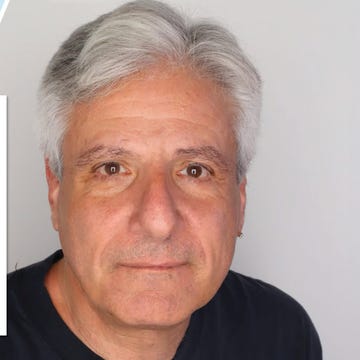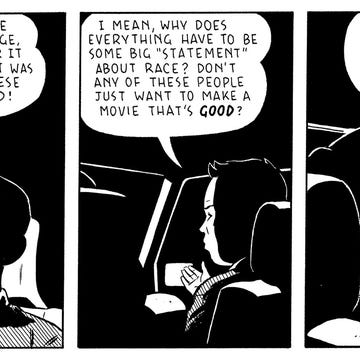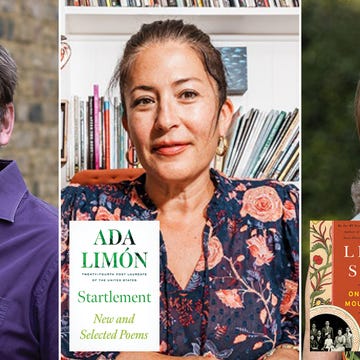It began with a drawing. Kinsale Drake was doodling on her tablet, depicting herself—wearing a T-shirt and a three-tiered long skirt with her signature Air Force 1s and Indigenous jewelry, her hair tied back in a traditional style—but she didn’t realize it yet. The girl in the drawing holds up a book adorned with a heart on the cover, another group of doodled hearts flowing out of it.
“She’s what Native literature can be,” Drake, a 23-year-old Diné poet, says over Zoom, brushing her pink-tinted dark hair behind her ears. “Which is a bunch of things at once that don’t contradict each other. They can exist in one place or one person.”
What Drake had been imagining with her self-portrait, what she had been longing for since childhood, was a group of creative, radically supportive Indigenous writers and poets bonded through literature by and for Indigenous people. Drake, a recent graduate of Yale University and the winner of the National Poetry Series and Joy Harjo Poetry Award, has a voice that is clear and confident from years of reading her work aloud. She talks about her younger self with gentleness and respect. “The little girl in me, she’s still there,” Drake says.
As a child, Drake spent her days between Southern California and Navajo Mountain in southern Utah on her grandmother’s farm. And after her grandmother’s death when Drake was in high school, grief emerged from her as poetry. She gained recognition from the poetry world, but she longed to expand on the networks within her Indigenous community for support. An internship at a mainstream publishing house, where her superiors made decisions based on budgets and donors, left her feeling lost.
“So some of it was, you know, as a writer, the frustration with, Well, if I were to publish a book, what would happen and would my voice be respected?” she says. “Or would it be sidelined?
“People like to use the word haunting when it comes to Native literature.” She elaborated, “There is no one Native. And we like making Native books fun. Native books should be for Natives too. And we deserve to have romance and comedies and things like that. I think that celebration is a huge part of what we do.”
For her senior thesis at Yale, Drake allowed herself to imagine what it would look like to form a creative community of Indigenous people, primarily women and queer people, determined to honor themselves, their families, and their communities. What emerged—in playful, bold, pink, and sparkling hues—became the NDN Girls Book Club.
The NDN Girls Book Club forgoes the traditional structure of reading one book a month together in community. Instead, the club dedicates its resources to hosting author talks and writing workshops, participating in events at book fairs across the country, and stocking Indigenous-run bookstores and tribal libraries with diverse titles by Indigenous authors. “We’re all gathered for a particular reason, which is the love of literature that we all possess. We are there to support the next generation,” Drake says.
The term girls represents a joy that Drake and her fellow book club members are trying to capture and, often, reclaim. Many of the youth involved in the book club have the same longing for community that a young Drake had. “We carved out representation for ourselves [while reading mainstream books by white authors],” Drake explains. She recalls thinking of Katniss Everdeen from the Hunger Games books as canonically Indigenous. Drake dreams of supplying every tribal library with care packages and imaginative books by Indigenous authors. Many of her favorite moments since the club launched have involved girls running up to the NDN Girls Book Club table at events, attracted to the club’s pink and playful aesthetic, and leaving with iridescent stickers and a new novel.
The book club also emphasizes the role of poetry in Indigenous culture and literature. The club’s poet map locates Indigenous writers in the United States and the world—without being limited by geography. “Indigenous poetry, for me, it hits different,” Oglala Lakota writer Pte San Win Little Whiteman, who met Drake through the youth poetry program Dances with Words and now hosts the NDN Girls Book Club’s writing workshops, says. “I see the healing aspect that happens with it.”
Part of this healing is achieved by building a leadership team, including Whiteman and Miss Indian Oklahoma Lily Painter, of young Native artists from different backgrounds and tribes. While goals for their work may be different, they are bonded by the value of togetherness. “Kinship and reciprocity are values that are grounded in a lot of the places that Native authors usually come from,” Drake says. Solidarity comes naturally to Drake. “I never saw any sort of other Native author as a competition. Rather, it was like, I want you to be in space with me. You make me feel stronger when we’re working together.”
For Whiteman, who turned to poetry to cope with isolation and mental health struggles, the NDN Girls Book Club has revealed a community close to home, on their reservation.
“There are so many more poets—there are more young people here that are writing their poetry than there were when I was their age, when I was younger,” they say. “It makes me very happy. And I want that to keep happening.”•
Join us on December 21 at 5 p.m., when author Carribean Fragoza will appear in conversation with California Book Club host John Freeman and special guest Kelly Link to discuss Eat the Mouth That Feeds You. Register for the Zoom conversation here.
VARIETY SHOW
Ursula Villarreal-Moura considers Carribean Fragoza’s short story “Sábado Gigante” in the context of her own experience growing up with the titular show. —Alta
IMMERSED IN REWILDING
Jessica Carew Kraft’s Why We Need to Be Wild: One Woman’s Quest for Ancient Human Answers to 21st Century Problems is a spiritual field guide that tells of the author’s quest for a “less harried life.” —Alta
“ONGOING EXPERIENCE”
A book club that started in Venice, California, spent nearly three decades reading James Joyce’s Finnegans Wake—and is now starting all over and reading it again. —New York Times
HOLIDAY SHOPPING
The McSweeney’s holiday pop-up shop in the Mission in San Francisco is open through December 24 and, among other things, carries the forthcoming February CBC title, Dave Eggers’s The Every. —San Francisco Chronicle
AGAIN AND AGAIN
Los Angeles neuroscientist Patrick House writes a fascinating piece about Critical Hits, edited by Carmen Maria Machado and J. Robert Lennon, and Frank Lantz’s The Beauty of Games. —Los Angeles Review of Books
LEAVING PRISON
Jacqueline Herron writes about the day she was released after four years and one month of incarceration at the California Institution for Women. —Air/Light
Alta’s California Book Club email newsletter is published weekly. Sign up for free and you also will receive four custom-designed bookplates.



















